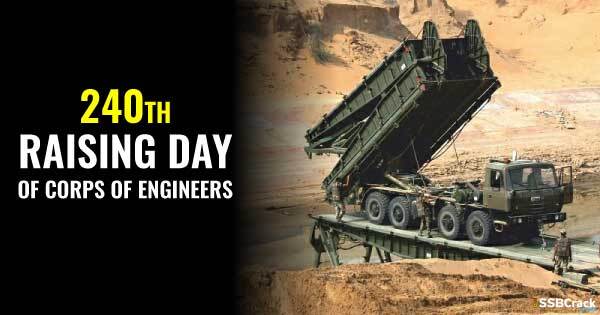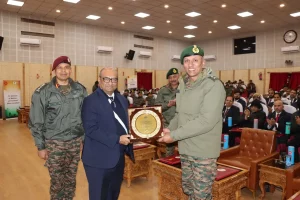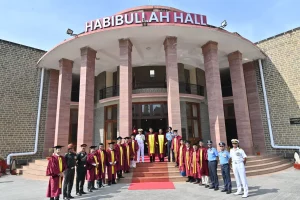240th Raising Day Of Corps Of Engineers, today. On this day in 1932, The Madras Sappers (1780), The Bengal Sappers (1803) and The Bombay Sappers (1820) gained individual recognition and identity from the initial companies of Engineers raised on 30 Sep 1780. In the past 240 yrs of its glorious history, The Madras Sappers (MEG) based in Bengaluru has been instrumental in many resounding victories both in India and abroad.
Corps of Engineers:
This branch is for the tech savvy guys of the Indian Army. All the engineer-related tasks are handled by these men. Combat Engineers, MES, BRO, MAP and Survey of India comes under this branch.
- Combat Engineers consists of three groups: Madras Sappers, Bengal Sappers and Bombay Sappers. They undertake construction works during wartime like building bridges to transport armoured tanks, etc.
Bridge constructed by combat engineers - Military Engineering Service (MES) is the only construction agency in the country which carries out all construction related tasks like the construction of residential and office buildings, hospitals, roads and runways, a marine structure like docks and harbours across the country including border areas.
- Border Roads Organisation (BRO) develops and maintains road networks in India’s border areas and friendly neighbouring countries.
- Married Accommodation Project (MAP) begun to construct married accommodation for the service personnel of the Indian Armed Forces.
- Survey of India is India’s central engineering agency in charge of mapping and surveying.
History:
The Corps of Engineers is one of the oldest arms of the Indian Army. The origin of the Corps dates back to 1780 when the two regular pioneer companies of the Madras Sappers were raised. Subsequently, the Group of Madras, Bengal and Bombay Sappers were formed and later merged on 18 November 1932 to form the Corps of Engineers in its present form.
The Corps of Engineers consists of four major constituents namely Combat Engineers, MES , Border Roads and Military Survey.
In war, Combat Engineers provide mobility to own forces by constructing bridges, tracks and helipads; on the other hand the Corps denies the same to the enemy by creating obstacles such as laying mine-fields and demolition of bridges.
The Corps of Engineers is replete with acts of bravery and valour. General PS Bhagat of the Corps remains the first Indian Officer to have won the Victoria Cross in the Second World War. Another first in the same war, Subedar Subramaniam was awarded the George Cross. Later, during Kashmir operation soon after Independence, Major R R Rane was awarded the Param Vir Chakra for making a passage through enemy mine fields while crawling in front of a tank.
Engineer units have been deployed abroad as part of UN Missions. They have brought laurels to our country by constructing bridges, opening lines of communication arid executing numerous humanitarian tasks.
The Military Engineering Service, which is an important part of the Corps has played a crucial role in Nation Building. It provides MES cover not only to the three Services, namely, Army, Navy and Air Force but also Defence Research & Development Organisation, KV Sangthan and Ordinance Factories. A number of prestigious and time bound projects have been completed over the years.
The Border Roads Organisation has made its own contribution to the nation by constructing national highways, airfields, buildings and bridges. The Border Roads, by constructing a large number of roads in once inaccessible areas of the Himalayas, Rajasthan and North Eastern States have contributed significantly to their economic development.
True to the motto SARVATRA, the Corps of Engineers has excelled in multifarious activities in war and peace. In peace time the Sappers have always been in the forefront in rendering aid to the civil authorities during natural calamities such as floods and earthquakes. Engineer units have also been engaged in the counter insurgency operations in J&K and the North East.
240th RAISING DAY OF CORPS OF ENGINEERS, today.
— SSBCrackExams (@SSBCrackExams) November 18, 2020
On this day in 1932, The Madras Sappers (1780), The Bengal Sappers (1803) and The Bombay Sappers (1820) gained individual recognition and identity from the initial companies of Engineers raised on 30 Sep 1780. pic.twitter.com/d2UBZElFJg
The Corps of Engineers provides combat engineering support, develops infrastructure for armed forces and other defence organisations, maintains lines of communication along India’s borders and provides relief to populace during natural disasters. These tasks are executed through four pillars of the Corps – Combat Engineers, Military Engineering Service, Border Roads Organisation and Military Survey.
The raising day is celebrated to commemorate the raising of the first engineering company in 1780. The modern day Corps of Engineers has three groups: Madras Sappers, Bengal Sappers and Bombay Sappers which were amalgamated into the Corps on 18 Nov 1932.



















